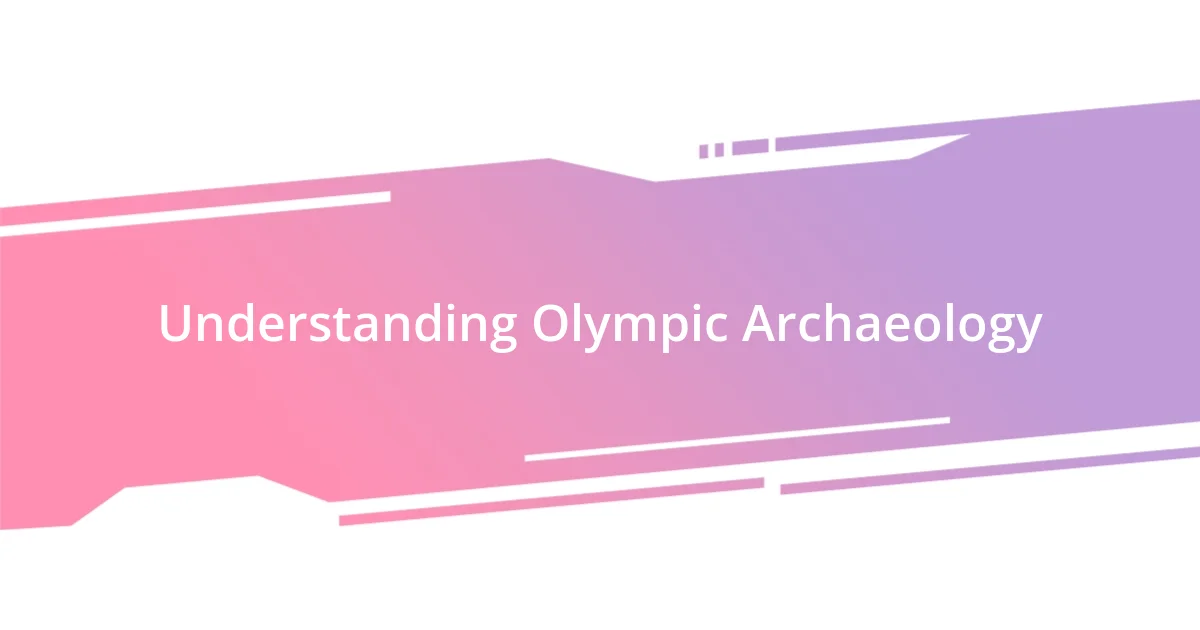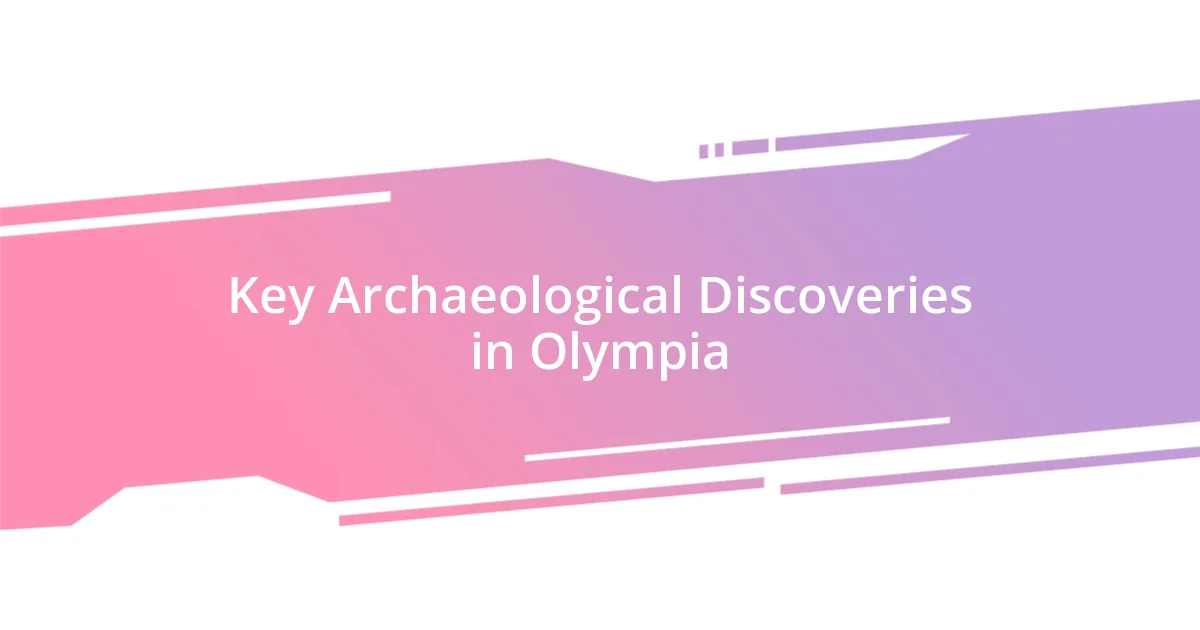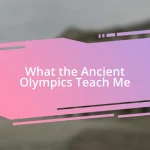Key takeaways:
- Olympic archaeology reveals the cultural, spiritual, and historical significance of ancient athletic sites, linking modern sporting ideals to past values and community spirit.
- Key discoveries in Olympia, such as the Temple of Zeus and ancient training grounds, highlight the depth of history and human aspiration associated with the Olympic Games.
- Future directions in Olympic archaeology will involve interdisciplinary research, advanced technology, and increased public engagement, fostering a deeper connection to cultural heritage and the lessons of the past.

Understanding Olympic Archaeology
Olympic archaeology is more than just digging in the ground; it’s uncovering the stories of ancient athleticism, culture, and community. I’ll never forget standing on the ancient grounds of Olympia, feeling the weight of history around me. Can you imagine the athletes, the pressure, and the joy as they competed thousands of years ago? Each artifact tells a tale of dedication and legacy.
What fascinates me is the way these discoveries connect us to our past, revealing the values and beliefs of ancient civilizations. For instance, I once stumbled upon a series of ancient inscriptions that spoke to the reverence held for victors. These moments remind us that the Olympics were not merely a competition; they represented a celebration of human spirit and perseverance. Isn’t it amazing how the echoes of those early athletes still resonate with us today?
As I delve deeper into Olympic archaeology, I’m continually amazed by how it reflects the evolution of sports and society. The remnants of training facilities, votive offerings, and competition equipment illustrate a rich tapestry of history that intertwines with our modern Olympic ideals. Have you ever wondered what it takes to unearth such impactful history? Each excavation provides a glimpse into the past, inviting us to understand not just what was, but what it means for us today.

Historical Significance of Olympic Sites
The historical significance of Olympic sites cannot be overstated. These ancient locations served as the heartbeat of the Olympic Games, where athletes pushed the limits of human achievement. I remember visiting the ruins of the stadium in Delphi, imagining the cheers of spectators and the sweat of competitors. This connection to the past left me pondering: what motivated those ancient athletes as they competed against each other? The dedication they showed transcends time, reminding us of the universal human drive to excel.
Each Olympic site embodies the cultural and religious practices of its era. For example, the altars and temples dedicated to Zeus at Olympia reveal the deep-rooted spiritual beliefs surrounding the Games. The first time I saw the remains of these structures, I felt a rush of reverence wash over me. It was as if the spirits of past champions were present, urging me to understand their rituals and traditions. These sites are more than just remnants; they are portals to understanding ancient values and societal structures that shaped the way we view sports today.
Furthermore, the artifacts discovered at these sites have reshaped our understanding of ancient civilizations. From pottery to statues, each find offers insight into everyday life, beliefs, and even the technical prowess of the people of that time. I once attended a lecture by an archaeologist who shared a fascinating story about a helmet found buried beneath the ancient training grounds. The details he provided painted a vivid picture of the life and times of athletes, making it clear that these sites are treasure troves of human history, enriching our modern Olympic experience.
| Site | Historical Significance |
|---|---|
| Olympia | Home of the ancient Olympic Games and religious center for Zeus. |
| Delphi | Major cultural hub, known for the Oracle and athletic competitions in ancient Greece. |
| Corinth | Hosted the Isthmian Games; key player in the development of sports culture. |

Key Archaeological Discoveries in Olympia
Archaeological discoveries in Olympia have unveiled layers of history that are simply breathtaking. When I first laid eyes on the remnants of the ancient stadium, I felt as if I was peering into a vivid past where athletes once pushed their limits. The energy of countless competitions seemed to linger in the air, reminding me of the weight of human aspiration that transcends centuries.
Here are some key archaeological discoveries that illustrate the depth of Olympia’s historical narrative:
- The Temple of Zeus: This magnificent structure housed the colossal statue of Zeus, considered one of the Seven Wonders of the Ancient World. I was awestruck picturing the grandeur that once stood there.
- The Ancient Gymnasium: Unearthed training grounds reveal training routines of ancient competitors. I imagined the scents of sweat and determination as athletes prepared for their events.
- Statues of Victors: Many statues were erected to honor winners of the Games. I remember feeling a sense of reverence, realizing each one tells a story of triumph against all odds.
Every artifact I encountered felt like a direct link to one of history’s grandest celebrations of human effort and spirit. The feeling of connection in that space is profound.

Techniques Used in Olympic Excavations
The techniques used in Olympic excavations are a fascinating blend of traditional archaeology and cutting-edge technology. Ground-penetrating radar, for instance, allows experts to visualize subsurface features without disturbing the earth. I remember feeling a mix of excitement and curiosity as I watched a team use this tool at the site of an ancient training facility. It was like peering through a window into history without breaking the glass.
In addition to advanced technology, meticulous stratigraphic excavation is crucial. This method involves carefully digging in layers, ensuring even the smallest artifacts are documented within their original context. I was struck by the patience and precision required for this technique. It reminded me of peeling an onion; you must take your time to truly appreciate all the hidden layers. Each layer tells a story, and when I unearthed a shard of pottery, I couldn’t help but wonder about the hands that once held it.
Moreover, collaboration with specialists enhances the excavation process. Archaeologists often work alongside historians and conservators to interpret findings accurately. I once attended a discussion where an archaeologist shared captivating insights from a cross-disciplinary project in Olympia. The blend of knowledge made every artifact come alive, transforming mere discoveries into rich narratives. How can one resist being drawn into the tapestry of human history woven through these techniques? It’s as if each dig is a page in an ancient book waiting to be read.

Implications for Modern Sports Culture
The implications of Olympic archaeology on modern sports culture go beyond mere historical interest; they challenge us to reconsider the values we ascribe to competition and achievement. For instance, as I explored the ruins of Olympic sites, I was struck by the communal spirit surrounding ancient athletic events. It made me reflect on how today’s sports can sometimes feel overly commercialized and narcissistic. Aren’t we missing something essential? The sense of camaraderie and shared celebration that once defined sports could re-emerge if we embraced the spirit of those ancient competitions.
Moreover, discovering artifacts that celebrated athletes not just as victors but as community figures reshapes our understanding of success. When I stumbled upon inscriptions honoring everyday athletes, I felt a wave of inspiration wash over me. This prompted me to think about how we often overlook the value of participation over victory in contemporary sports. Shouldn’t we highlight the stories of those who strive, regardless of medals? By doing so, we can foster a culture that respects effort and determination just as much as it does outright victories.
Engaging with the history of the ancient Olympic Games ignites a personal connection that I believe modern sports culture desperately needs. I often find myself pondering how our relationship with sports can be deepened by honoring its legacy. When we bring the lessons from the past into our present—acknowledging both triumphs and struggles—we can cultivate an environment that truly appreciates the human spirit’s resilience. Isn’t that something worth striving for?

Opportunities for Engagement in Archaeology
Exploring opportunities for engagement in archaeology truly fuels my passion for the subject. Volunteering on excavation sites, for instance, allows anyone to roll up their sleeves and participate in uncovering history. I once had the chance to join a summer dig, where I felt an exhilarating blend of purpose and awe as I sifted through dirt that had not seen the light of day for centuries. Can you imagine holding an artifact that carries the whispers of the past?
Educational programs offered by museums and universities often provide an excellent pathway to engage with archaeology, catering to diverse audiences. I remember attending a workshop which combined lectures and hands-on activities, allowing participants to experience the thrill of artifact analysis firsthand. It made me realize how accessible archaeology can be; all it takes is curiosity and a willingness to learn. Isn’t it incredible how knowledge can transform a simple trip to a museum into a journey through time?
Moreover, digital platforms offer exciting new avenues for engagement. Virtual reality experiences that recreate ancient sites can immerse users in a way that textbooks simply can’t match. I once explored a VR simulation of the ancient Olympic stadium, and I was utterly captivated by the lifelike atmosphere. This kind of interaction fosters a deeper connection to the past, prompting reflection on how much we can learn from those who came before us. How thrilling it is to realize that history is not just a distant memory but something we can actively explore and experience!

Future Directions in Olympic Archaeology
As I look to the future of Olympic archaeology, I can’t help but feel a sense of excitement about the potential for interdisciplinary research. Collaborations between archaeologists, sports historians, and cultural anthropologists could really enhance our understanding of the ancient Games. Imagine what we could uncover about societal values and cultural practices if all these experts brought their perspectives together! It feels like a promising avenue, ripe for exploration.
One thing I believe will shape future research is the integration of technology. Tools such as 3D scanning and remote sensing are revolutionizing how we study archaeological sites. I was fascinated when I witnessed a demonstration of ground-penetrating radar at a conference. This technology allows us to visualize structural remains without digging, preserving the context of artifacts. Isn’t it astounding to think about how these advancements can deepen our insights into the past while respecting the layers of history that deserve careful evaluation?
Looking ahead, public involvement in Olympic archaeology is crucial. I envision more opportunities for enthusiasts and communities to participate in ongoing research projects. While attending a local heritage event, I experienced firsthand the enthusiasm of volunteers eager to engage with their history. It was heartening to see young people asking questions and sharing their own perspectives. How rewarding would it be if future generations form a deeper connection to their cultural heritage through active participation in archaeology? This shared engagement could lead to a vibrant dialogue that honors the legacy of the ancient Olympics while inspiring collective appreciation for our shared human story.














